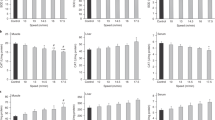Summary
The studies were carried out on male Wistar rats subjected to running within an electric rotating drum. The animals were divided into four experimental groups, differing one from another as to the duration of training. Each training session lasted 30 days. In the first group the daily run lasted 3 min, in the second group 5 min; in the third group, a 1 min run on the first day, and one min longer on each successive day; in the fourth group a 2 min run on the first day and for two min longer on each successive day.
The determinations made prior to and after training included the peripheral blood erythrocyte (Er) and reticulocyte (Ret.) count, the hemoglobin concentration (Hb) and packed cell volume (PCV) and, determined by spectrophotometric methods, the activity of pyruvate kinase (PK), glucose-6-phosphate dehydrogenase (G6PD) and glutathione reductase (GR). Training induced an improvement of all enzymatic activities. The heavier the physical exertion, the more intensive was the enzymatic activity of red blood cells, due to the intensification of bone marrow erythropoetic activity under physical exertion and the appearance of young red cells in peripheral blood. All the experimental groups revealed a drop in erythrocyte count (Er), hemoglobin concentration (Hb), and hematocrit values (PCV), as well as an increase in the reticulocytes count (Ret) and in the activity of all the enzymes investigated. In the fourth group anemia was detected: prolonged endurance training decreased the RBC by 24.2%, Hb by 31.1%, PCV by 26.2% and increased the reticulocyte count by 881.6%. Pronounced loading with physical effort leads to shifts in the glucose utilization ratio along particular erythrocyte metabolic pathways. This change in enzymatic activities may prove to be one of the causes of faster elimination of old RBCs.
Similar content being viewed by others

References
Berger J (1981) Seasonal variations in reticulocyte counts in blood of laboratory mice and rats. Z Versuchstierk 23:8–12
Beutler E (1975) A mannual of biochemical methods. The red cell. Grune and Stratton, New York
Beutler E (1979) Red cell enzyme defects as nondiseases and as diseases. Blood 1:1–7
Bishop C, Surgenor DM (1964) The red blood cell. Academic Press, New York London
Fornaini GM, Dacha M, Accorsi A, Faci A, Piatti E (1981) Glucose utilization in human erythrocytes during physical exercise. Med Sci Sports Exercise 13:322–324
Jacob HS, Jandl JH (1966) Effects of sulphydryl inhibition on red cells. Glutathione in the regulation of the hexose monophosphate pathway. J Biol Chem. 241:4243–4250
Mairbaurl H, Humpeler E, Schweberger G, Pessenhofer H (1983) Training dependent changes of red cell density and erythrocytic oxygen transport. J Appl Physiol 55:1403–1407
Paniker NY, Srivastava SK, Beutler E (1970) Glutathione metabolism of the red cells. Effect of glutathione reductase deficiency on the simulation of hexose monophosphate shunt under oxidative stress. Biochim Biophys Acta 215:456–460
Refsum HE, Jordfald G, Stromme SB (1979) Hematological changes following prolonged heavy exercise. Med Sport vol. 9 in: advances in exercise physiology. Karger, Basel, pp 91–99
Remes K, Vuopio P, Harkonen M (1979) Effect of long term training and acute physical exercise on red cell 2,3-DPG. Eur J Appl Physiol 42:199–207
Seaman C, Wyss S, Piomelli S (1980) The decline in energetic metabolism with aging of the erythrocyte and its relationship to cell death. Am J Hematol 8:31–42
Stewart GA, Steel JE, Toyne AH (1972) Observations on the hematology and the iron and protein intake of australian olimpic athletes. Med J Austr 2:1339–1343
Uddin DE, Puligaudla B, Stass SA, Schumacher H (1978) Low hematocrits during basic training: athletes anemia? N Engl J Med 21:1192–1193
Wiesmann U, Tonz O, Richterich R, Verger P (1965) Die erythrocyten puryvate kinaze bei gesunden und bei nichtspharocytarer hamolytischer pyruvate kinaze. Klin Wochenschr 43:1311–1318
Wilkerson J, Cutin B, Horvarth SM (1977) Exercise-induced changes in blood, red cell and plasma volumes in men. Med Sci Sports 3:155–158
Author information
Authors and Affiliations
Rights and permissions
About this article
Cite this article
Spodaryk, K., Szyguła, Z., Dabrowski, Z. et al. The activity of erythrocyte enzymes in rats subjected to running exercises. Europ. J. Appl. Physiol. 54, 533–537 (1985). https://doi.org/10.1007/BF00422965
Accepted:
Issue Date:
DOI: https://doi.org/10.1007/BF00422965


